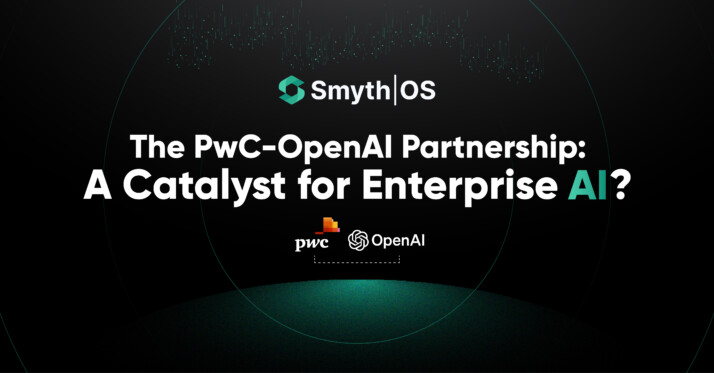The recent partnership between PwC and OpenAI is making a lot of noise.
“The PwC-OpenAI partnership marks a pivotal moment for enterprise AI. The real power of AI lies in seamlessly integrating it across all business processes. By embedding AI into every facet of operations, we unlock unprecedented efficiency and innovation,” said Alexander De Ridder, CTO of SmythOS.
As one of the largest professional services firms globally, PwC’s decision to not only utilize OpenAI’s ChatGPT Enterprise but also become a reseller of the technology is a resounding affirmation that generative AI is ready for prime time.
It’s a wake-up call for every business leader: The age of AI is here, and it’s moving fast. Standing still means falling behind.
But as more global powerhouses race to adopt these tools, I can’t help but think: are we missing a crucial piece of the puzzle?

Bringing AI into large organizations is one thing. It’s a priority in every boardroom across the globe, and rightfully so. But weaving that technology into the very fabric of how they operate – from data analysis, to inventory management, to sales and marketing – that’s where the real transformation happens.
And that’s where AI Orchestration and Multi Agent Systems come in.
Imagine a future where AI isn’t just a tool, but an omnipresent, intelligent partner. A future where every application, every process, every decision, and every human interaction is enhanced by the power of AI. This is the future that AI orchestration platforms like SmythOS are making possible.
→ Picture this: A sales representative is preparing for a critical client meeting. With a few clicks, she summons an AI agent that scours the CRM for insights on the client’s preferences, analyzes past interactions, and even scans external news sources for relevant updates. Another agent, specializing in content creation, quickly generates a personalized presentation deck, complete with data visualizations and persuasive language.
→ Meanwhile, in the supply chain department, AI agents are continually monitoring inventory levels, predicting demand fluctuations, and optimizing logistics in real-time. They’re communicating with AI agents in the finance department to ensure optimal cash flow and resource allocation.
→ And in the C-suite, executives have access to a holistic, AI-powered view of the organization. Real-time data from across the enterprise is synthesized and analyzed, enabling data-driven decision making at a scale and speed previously unimaginable.
This is the power of AI orchestration. It’s not about deploying AI in silos, but about weaving it into the very fabric of the organization. It’s about creating a symbiotic relationship between human and machine, where each enhances the other.
So, what does this mean for the PwC and OpenAI Deal?
While the partnership is undoubtedly a significant milestone, it’s just the beginning of PwC’s commitment to investing nearly $1 billion into Artificial Intelligence. To truly maximize their investment and build an AI ecosystem that future-proofs their organization for decades to come, here are three key considerations for PwC:
- Embrace AI Orchestration: Deploying ChatGPT is a great start, but the real magic happens when you integrate it with your existing systems, processes, and tools. This is where AI orchestration platforms like SmythOS come in. By enabling the seamless integration and coordination of multiple AI agents, including ChatGPT, SmythOS can help PwC weave AI into the very fabric of their operations. This means not just using AI for isolated tasks, but integrating it into every aspect of their work, from client engagement and service delivery to internal operations and decision making.
- Embrace the Power of AI Orchestration: Deploying ChatGPT is not the end game – it’s just the beginning. To truly harness the transformative potential of AI, PwC must go beyond single-tool adoption and embrace AI orchestration. This is where platforms like SmythOS come in. By enabling the seamless integration and coordination of multiple AI agents, including ChatGPT, SmythOS can help PwC weave AI into the very fabric of their operations. A world where every client engagement, every service delivery, every internal process is enhanced by the power of coordinated, intelligent automation. Where AI isn’t just a tool, but a pervasive force multiplier, driving efficiency, insights, and innovation across the entire organization.
- Think Beyond Efficiency: While the efficiency and productivity gains from AI can be significant, the true potential of AI lies in its ability to drive innovation and value creation. As PwC integrates AI into their operations, they should be thinking not just about how to do things faster or cheaper, but about how to do things differently – how to create new services, new experiences, new ways of delivering value to clients. This requires a shift in mindset from seeing AI as a tool for optimization to seeing it as a catalyst for transformation.
By embracing AI orchestration, empowering their people, and thinking beyond efficiency, PwC can not only maximize the value of their OpenAI partnership but set themselves up for long-term success in the AI-powered future.
Of course, this journey is not without its challenges. It requires significant investment, a willingness to experiment and learn, and a deep commitment to responsible and ethical AI deployment. But the potential rewards – in terms of competitive advantage, client value, and societal impact – are immense.
The PwC-OpenAI deal is a signal of the AI revolution that’s underway. But it’s just the beginning. The real opportunity lies in what comes next – in how organizations like PwC harness the power of AI, not as a one-off tool, but as a pervasive, intelligent force for transformation.
As a leader in AI orchestration, SmythOS is ready to partner with forward-thinking organizations like PwC on this journey. Our platform and expertise can help accelerate PwC’s AI transformation, enabling them to not just imagine the future, but to create it.
